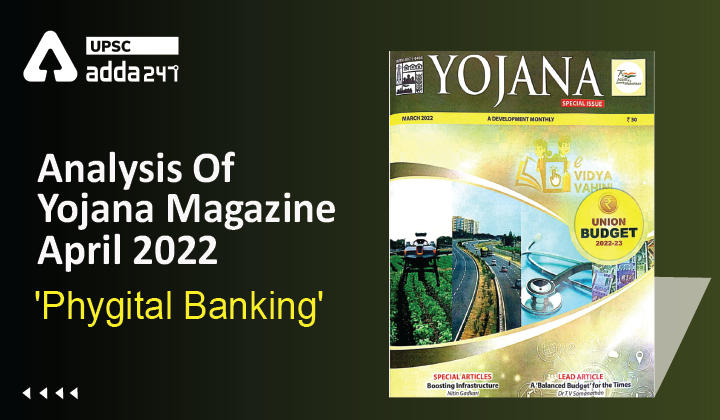Table of Contents
Analysis Of Yojana Magazine
”Phygital Banking”
Relevance
”GS 3: Mobilization of Resources, Growth & Development”
Introduction
- Around 90 per cent of the banking transactions in India have now started moving into the non-branch channel such as internet banking, mobile banking or ATM.
- However, physical branches will continue to be relevant as a large percentage of customers are more comfortable doing transactions at branches.
- There is still a significant population who will be more comfortable in one-to-one dealings rather than only digital.
- Therefore, this world of physical plus digital or phygital will be the way forward.
What is Phygital Banking?
- Phygital or Hybrid model is a combination of the phrases physical and digital banking.
- It is a service where traditional and digital models co-exist, and customers get the best of both worlds.
- It gives the personalization, relationship and in-person experience of physical branch touchpoint and the efficiency, flexibility and convenience of digital services.
- It’s a disruptive model that utilises both human labour and innovative technology.
Advantages of going Phygital
Increased Customer Value and Cost Reduction
- The Phygital mode of lending has reduced costs, and it delivers increased value to customers.
- By automating repetitive backend & frontend tasks and reducing the processing time for paperwork, phygital model negates the need to employ a large workforce or invest in expensive real estate.
Improved Customer Experiences through Omnichannel
- Phygital set-ups are the most viable solution for patrons who wish to seamlessly change their choice of engagement touchpoints.
- They have the option to either use smartphone, tablet, kiosk, digital wall, or touch-tables installed in the branch to gain product knowledge, or they can simply talk to one of the trained staff to discuss their doubts directly.
Anticipating Valuable Customer Needs
- Innovative technologies such as AI, ML, and data analytics segregate a patron’s individualized data on a secure database.
- This provides keen insights and enables phygital NBFCs to anticipate what that customer might need in the future and deliver personalized products and services directly to them.
Securing a Wider Market Share
- The world is at a juncture where there are discussions surrounding open banking regulations to help banks & NBFCs, become more transparent and secure (data-wise).
- Phygital can build a connected ecosystem and work as a facilitator between the urban and the rural, where digital is still not widely accepted.
Improved Relationships between NBFCs and Customers
- Phygital ensures the existence and availability of branches while leveraging FinTech solutions and self-service platforms at every touchpoint, building trust and making the entire banking journey hassle-free and satisfactory for patrons.
How did Phygital become a new banking frontier for the NBFC sector?
- NBFCs have taken great initiatives in the last couple of years, making the function more agile and mobile for individuals.
- With the help of advanced technologies like AI, Automation and Chatbots, the NBFC sector has grown and reduced the dependency on physical kiosks.
- Adoption of advanced technologies have reduced the cost of NBFC companies in customer acquisition, servicing existing customers, or de-risking the portfolio while trying to overcome the increasing formal credit penetration in a growing economy.
- With the new hybrid model, the key for smart banking will be to find the right balance to create an agile business & engaged customer, as an accomplishment to the great learnings of 2020.
- Enabling agricultural NBFCs to access low-cost capital and deploy a ‘phygital’ (physical + digital) model for achieving better long-term digital outcomes.
Way Forward
-
In the post-Covid era, building resilient systems and encouraging business models that could be change-makers of the future are crucial.
- Fintech players, alongside the conventional financial services providers, hold the key to transforming the way the economy functions and increasing access to credit for our industry.
Conclusion
As we tread ahead on the growth path after the pandemic, India’s rightful place in the global economy will be built on a sound, stable and resilient financial system. Banks and NBFCs, being the power engines of our economy, must undergo continual metamorphosis to accelerate this transformational journey.



 TSPSC Group 1 Question Paper 2024, Downl...
TSPSC Group 1 Question Paper 2024, Downl...
 TSPSC Group 1 Answer key 2024 Out, Downl...
TSPSC Group 1 Answer key 2024 Out, Downl...
 UPSC Prelims 2024 Question Paper, Downlo...
UPSC Prelims 2024 Question Paper, Downlo...
